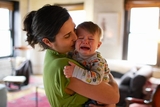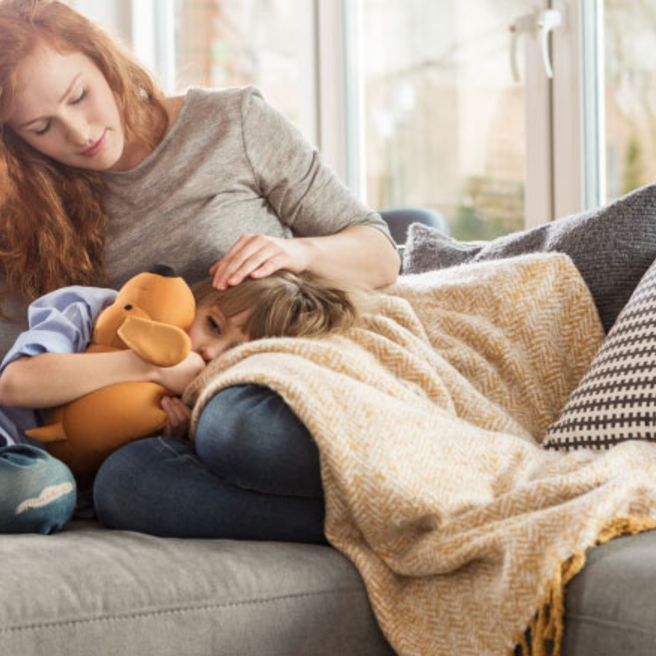
Last year, respiratory syncytial virus (RSV) hit hard, and it's now spiking again. While for most kids, RSV is just a miserable cold virus, for others, it can lead to hospitalization or an admission to the intensive care unit.
As we navigate another RSV season, common-sense prevention tips, plus new preventive medications and vaccines can make a big difference for little ones at risk for getting the sickest. Learn more about how to prevent RSV and, if your child does get it, how to ease their discomfort and get through the worst of it at home, if possible.
What is RSV?
RSV is a virus that causes a miserable cold with thick mucus and a cough that can last a month. You can get the infection at any age and more than once in your lifetime. RSV tends to be particularly tough on babies and toddlers who catch it because the first time around is usually the worst.
In most cases, RSV symptoms are mild enough to be managed at home. But there are some red flags to watch out for that might require a trip to the doctor.
How to prevent RSV
Practice trusted infection prevention steps! This means good handwashing and staying home when sick to prevent the spread of germs.
Get any available preventive medications or vaccinations before the RSV season starts. In addition to vaccines available for pregnant people and adults over 60, a new preventive medication is now recommended by the Centers for Disease Control and Prevention (CDC) for babies before or during their first RSV season. The medication's name is Beyfortus (Nirsevimab). It is a single dose “monoclonal antibody” given in one shot into the muscle. It puts antibodies into the bloodstream that will help babies fight the virus. It decreases the chances of getting very sick and landing in the hospital from RSV.
How to tell if my child has RSV
Signs of RSV typically peak on days three, four and five of illness. They may include:
- Runny nose
- Coughing
- Sneezing
- Loss of appetite
- Fever
- Wheezing
How to treat RSV at home
Like all colds, there is no medication to cure RSV. However, here's how you can ease your child's discomfort at home:
- Clear up congestion. If your little one can’t (or won’t) blow their nose, put a drop or two of nasal saline in each nostril. Use a suction device like a bulb syringe to pull out the discharge. Warning: Excessive bulb suctioning can be irritating to the nose. Sometimes the saline alone is enough to promote sneezing, which will shoot out the mucus.
- Pick up steam. Run a cool mist humidifier in your child’s bedroom and give steamy baths. The water vapor loosens congestion. Note: Use a cool mist humidifier rather than a vaporizer, which is a burn hazard.
- Let honey help. If your child is at least a year old, try giving them honey to help relieve their cough. Honey works as well as popular over-the-counter cough medications without the side effects.
- Relieve pain. Give acetaminophen (if over 2 months of age) or ibuprofen (if over 6 months of age) as needed for fever or discomfort. These medications can help ease muscle aches, headaches and sore throats. For ear pain, you can also put a warm washcloth over the ear.
- Stay hydrated. For infants, breast milk or formula are best for hydration because of their nutrients. For older children, mix it up. Make sure there is salt and sugar in their fluids if they are not eating. Apple juice, water, popsicles, milk, soup, and foods like watermelon and cucumbers are also great sources of hydration. Milk will not make mucus worse.
How to know if a medical visit is needed
So how do you know when to take your child for medical care? Trust your instincts when trying to decide if a child’s cold requires medical attention.
If you are not certain, call your child’s pediatrician’s office. You can also use the CHOP symptom checker to help you determine how serious their symptoms are. If your child has other medical conditions, has a weakened immune system, or sees a specialist, be sure to check with their specialty care team.
In general, keep an eye out for these signs of a more serious case:
- Breathing trouble. This looks like:
- Rapid breathing
- Using extra muscles to breathe (watch for them using their shoulders or stomach to breathe, and look for the skin between the ribs getting sucked in with each breath)
- Grunting at the end of each breath
- Nostrils flaring with each breath
- Pale or blue lips/mouth
- Inability to breathe and drink at the same time
- Lethargy
- Dehydration. Most kids urinate every three to six hours or so. You know your child’s baseline. If you struggle to keep them hydrated and they don't pee as much as usual, they need medical attention. Other signs of dehydration include a dry mouth, lethargy and lack of tears when crying.
- Pain: Like all colds, a child with RSV might develop ear infections, pneumonia or a sinus infections. Pay attention to complaints of ear pain, chest pain or sinus pain.
The bottom line
Don't panic! If your child is eligible, you can be proactive and take advantage of the antibody treatment to help prevent serious illness. If they do get sick, take steps to ease your child’s discomfort and get through the worst of it at home, use your judgement, and watch for the above warning signs.
We’ll get through this together!
Last year, respiratory syncytial virus (RSV) hit hard, and it's now spiking again. While for most kids, RSV is just a miserable cold virus, for others, it can lead to hospitalization or an admission to the intensive care unit.
As we navigate another RSV season, common-sense prevention tips, plus new preventive medications and vaccines can make a big difference for little ones at risk for getting the sickest. Learn more about how to prevent RSV and, if your child does get it, how to ease their discomfort and get through the worst of it at home, if possible.
What is RSV?
RSV is a virus that causes a miserable cold with thick mucus and a cough that can last a month. You can get the infection at any age and more than once in your lifetime. RSV tends to be particularly tough on babies and toddlers who catch it because the first time around is usually the worst.
In most cases, RSV symptoms are mild enough to be managed at home. But there are some red flags to watch out for that might require a trip to the doctor.
How to prevent RSV
Practice trusted infection prevention steps! This means good handwashing and staying home when sick to prevent the spread of germs.
Get any available preventive medications or vaccinations before the RSV season starts. In addition to vaccines available for pregnant people and adults over 60, a new preventive medication is now recommended by the Centers for Disease Control and Prevention (CDC) for babies before or during their first RSV season. The medication's name is Beyfortus (Nirsevimab). It is a single dose “monoclonal antibody” given in one shot into the muscle. It puts antibodies into the bloodstream that will help babies fight the virus. It decreases the chances of getting very sick and landing in the hospital from RSV.
How to tell if my child has RSV
Signs of RSV typically peak on days three, four and five of illness. They may include:
- Runny nose
- Coughing
- Sneezing
- Loss of appetite
- Fever
- Wheezing
How to treat RSV at home
Like all colds, there is no medication to cure RSV. However, here's how you can ease your child's discomfort at home:
- Clear up congestion. If your little one can’t (or won’t) blow their nose, put a drop or two of nasal saline in each nostril. Use a suction device like a bulb syringe to pull out the discharge. Warning: Excessive bulb suctioning can be irritating to the nose. Sometimes the saline alone is enough to promote sneezing, which will shoot out the mucus.
- Pick up steam. Run a cool mist humidifier in your child’s bedroom and give steamy baths. The water vapor loosens congestion. Note: Use a cool mist humidifier rather than a vaporizer, which is a burn hazard.
- Let honey help. If your child is at least a year old, try giving them honey to help relieve their cough. Honey works as well as popular over-the-counter cough medications without the side effects.
- Relieve pain. Give acetaminophen (if over 2 months of age) or ibuprofen (if over 6 months of age) as needed for fever or discomfort. These medications can help ease muscle aches, headaches and sore throats. For ear pain, you can also put a warm washcloth over the ear.
- Stay hydrated. For infants, breast milk or formula are best for hydration because of their nutrients. For older children, mix it up. Make sure there is salt and sugar in their fluids if they are not eating. Apple juice, water, popsicles, milk, soup, and foods like watermelon and cucumbers are also great sources of hydration. Milk will not make mucus worse.
How to know if a medical visit is needed
So how do you know when to take your child for medical care? Trust your instincts when trying to decide if a child’s cold requires medical attention.
If you are not certain, call your child’s pediatrician’s office. You can also use the CHOP symptom checker to help you determine how serious their symptoms are. If your child has other medical conditions, has a weakened immune system, or sees a specialist, be sure to check with their specialty care team.
In general, keep an eye out for these signs of a more serious case:
- Breathing trouble. This looks like:
- Rapid breathing
- Using extra muscles to breathe (watch for them using their shoulders or stomach to breathe, and look for the skin between the ribs getting sucked in with each breath)
- Grunting at the end of each breath
- Nostrils flaring with each breath
- Pale or blue lips/mouth
- Inability to breathe and drink at the same time
- Lethargy
- Dehydration. Most kids urinate every three to six hours or so. You know your child’s baseline. If you struggle to keep them hydrated and they don't pee as much as usual, they need medical attention. Other signs of dehydration include a dry mouth, lethargy and lack of tears when crying.
- Pain: Like all colds, a child with RSV might develop ear infections, pneumonia or a sinus infections. Pay attention to complaints of ear pain, chest pain or sinus pain.
The bottom line
Don't panic! If your child is eligible, you can be proactive and take advantage of the antibody treatment to help prevent serious illness. If they do get sick, take steps to ease your child’s discomfort and get through the worst of it at home, use your judgement, and watch for the above warning signs.
We’ll get through this together!
Recommended reading
Signs of Respiratory Distress in Children
Detailed information on the signs of respiratory distress in children.
Calming Your Child's Cough

Catching a cold is a normal part of being a child. Coughing that comes along with the cold is a key part of the body’s recovery process.